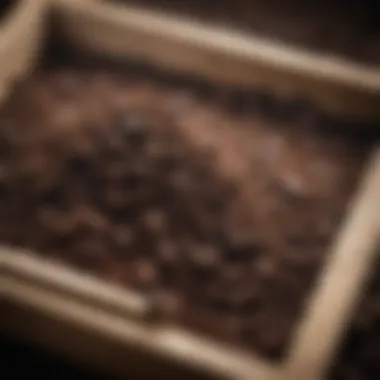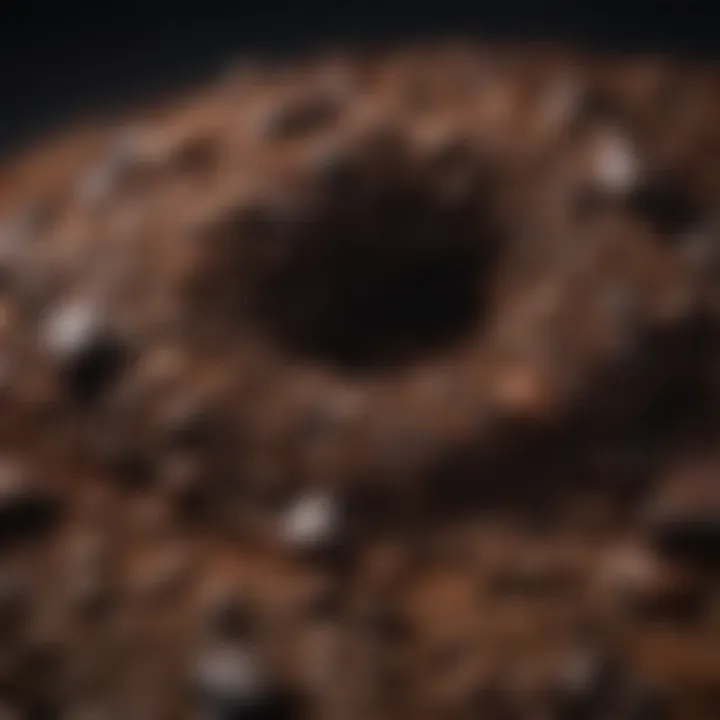Unlocking the Potential of Dried Coffee Grounds


Intro
Dried coffee grounds present a unique opportunity to extract value from what is often considered waste. As society becomes increasingly aware of sustainability and the potential for recycling, the conversation around coffee grounds has gained traction. In this narrative, we aim to unravel the various uses of dried coffee grounds, from gardening to health applications, and explore the impact on environmental sustainability.
The relevance of this topic cannot be overstated. With millions of coffee enthusiasts globally, the waste generated can be significant. By understanding how to repurpose dried coffee grounds, we not only reduce waste but also create opportunities for innovative uses. This will contribute to a more sustainable future while providing practical benefits to individuals and communities.
Through exploring these multifaceted applications, we aim to deliver insights that resonate across various fields, including education, research, and urban living. The implications of effectively utilizing dried coffee grounds extend beyond mere utility; they speak to a broader commitment to an eco-friendly lifestyle.
In what follows, we will delve into the research surrounding the properties of dried coffee grounds and their diverse applications.
Research Overview
Understanding the scientific basis behind the applications of dried coffee grounds is essential for validating their value. Significant research has been conducted to uncover their properties and potential uses. This section will focus on methodological approaches and the implications that arise from the findings.
Methodological Approaches
Research on dried coffee grounds employs a variety of techniques, including experimental studies, literature reviews, and case studies. For example, studies might analyze the chemical composition of coffee grounds to reveal nutrients beneficial for soil health, or experimental setups may test their effectiveness in pest control.
The approaches taken can vary, for one, agronomists may focus on the impact of coffee grounds on plant growth, while environmental scientists might emphasize the reduction of landfill waste. This variety contributes to a holistic understanding of how dried coffee grounds can be utilized across domains.
Significance and Implications
The significance of utilizing dried coffee grounds extends into several arenas. From an environmental perspective, recycling coffee waste helps mitigate the growing problem of organic waste in landfills, which contributes to greenhouse gas emissions. Furthermore, the academic implications for research and education are immense.
"Utilizing waste materials not only serves practical purposes but also fosters an academic culture of innovation and sustainability."
The insights gained from this research can guide practices in horticulture, waste management, and public policy, leading to improved environmental outcomes. In the next sections, we will explore contemporary trends in science relating to this topic.
Understanding Dried Coffee Grounds
The significance of understanding dried coffee grounds in this article cannot be overstated. With a rising interest in sustainability, many people are seeking ways to utilize everyday waste, and coffee grounds are a prime example. Once considered merely a byproduct of the brewing process, dried coffee grounds now present a myriad of application opportunities across various domains. Their potential extends beyond mere disposal, culminating in rich benefits for gardening, health, and waste reduction.
In exploring the value of dried coffee grounds, we will delve into their definition, the processes that generate them, and the inherent chemical makeup that defines their multifunctionality. This structured approach will provide readers with a well-rounded grasp of why dried coffee grounds deserve consideration and utilization beyond the simple act of brewing a cup of coffee.
Defining Dried Coffee Grounds
Dried coffee grounds are the solid remnants left after brewing coffee. They consist of the leftover particulate of ground coffee beans, primarily generated through the infusion of hot water. Once the liquids are extracted, the grounds can be dried to reduce moisture content. The resultant dried substance is rich in organic material and can serve various practical purposes.
Understanding what constitutes dried coffee grounds helps to highlight their versatility. Not only do they contain trace amounts of nutrients beneficial for plants, but they also carry compounds that can aid in natural pest control and even skin care. Here, dried coffee grounds emerge as a potent resource rather than waste, encouraging innovative recycling practices.
The Coffee Brewing Process
The coffee brewing process is pivotal in understanding dried coffee grounds. Brewing typically involves several steps: sourcing coffee beans, grinding them, and then using water as a solvent to extract flavors and aroma.
- Sourcing Coffee Beans: Choosing high-quality beans affects the flavor and composition of the grounds.
- Grinding: The size of the grind will influence extraction; finer grounds yield more flavor.
- Brewing: The method, whether drip, French press, or espresso, impacts both flavor profiles and the composition of the resultant grounds.
Throughout this process, the soluble elements such as sugars, oils, and acids are extracted. What remains—the dried coffee grounds—holds significant potential for various uses, and understanding the nuances of this process is essential for harnessing their value effectively.
Chemical Composition Analysis
The chemical composition of dried coffee grounds is a critical factor that contributes to their diverse applications. They contain a variety of compounds, such as caffeine, lipids, and antioxidants.
- Caffeine: Known for its stimulating effects, caffeine can also act as a natural pest deterrent in gardens.
- Lipids: These fats contribute to a rich organic content, enhancing soil fertility when used in compost.
- Antioxidants: Compounds in coffee grounds exhibit properties that aid in various health aspects, including skin protection and inflammation reduction.
The complexity of chemical makeup makes dried coffee grounds a scientifically intriguing subject. By examining the constituents found within, we can better appreciate how they function in different applications and what benefits they can provide in areas such as agriculture and wellness.
"Dried coffee grounds exemplify how we can turn waste into valuable resource, highlighting the need for sustainable practices in our daily lives."
This exploration of dried coffee grounds further supports the broader discourse on environmental sustainability and resource utilization, pushing boundaries for innovative applications. As this article unfolds, we will delve deeper into their nutrient profile, applications in gardening, and many other uses that challenge conventional disposal practices.
Nutrient Profile of Dried Coffee Grounds
The nutrient profile of dried coffee grounds is vital for understanding their broader implications and applications. Coffee grounds are not merely a waste product; they can be transformed into a source of nutrients and health benefits. Their nutrient content, along with their antioxidant properties, contributes to various uses in different fields. Up till now, people often dispose of coffee grounds without recognizing their potential. Highlighting their nutrient profile can promote an eco-friendly approach to coffee consumption and waste management.


Macronutrients and Micronutrients
Dried coffee grounds contain a significant amount of both macronutrients and micronutrients, making them beneficial for soil and possibly health. The primary macronutrients found in coffee grounds are nitrogen, phosphorus, and potassium. These components are essential for plant growth. For example:
- Nitrogen: It is crucial for the development of leaves and stems. This makes coffee grounds a suitable addition to compost, enhancing its quality.
- Phosphorus: This serves the role of promoting root growth and flowering in plants.
- Potassium: It helps in the overall functioning of processes such as photosynthesis and water regulation in plants.
In terms of micronutrients, dried coffee grounds offer iron, magnesium, and calcium. These are less dominant but still important for healthy growth. Iron deficiency can lead to yellowing of plants, and calcium helps with cell wall structure. These nutrients support the idea that coffee grounds are more than waste; they play a pivotal role in nutrient supply.
Antioxidant Properties
Antioxidants in dried coffee grounds present exciting possibilities. Chemical analysis reveals high levels of antioxidants such as chlorogenic acid. These compounds can neutralize free radicals, potentially reducing oxidative stress. In the context of health, this property is significant as it can contribute to lowering the incidence of chronic diseases, including heart disease and certain types of cancer.
Moreover, the inclusion of antioxidants in gardening can improve soil health. Healthy soil supports plant growth by fostering beneficial microbial activity. Utilizing dried coffee grounds helps not just humans but also contributes to a balanced ecosystem in gardens and farms.
"Coffee grounds contain impressive levels of antioxidants, providing dual benefits for both health and the environment."
Potential Health Benefits
The potential health benefits of dried coffee grounds extend beyond their antioxidant properties. They have been found to aid in skin care, especially due to their exfoliation capabilities. Exfoliation helps in removing dead skin cells, thus promoting healthier skin. Various skincare products have started incorporating coffee grounds, echoing this natural treatment's efficacy.
Additionally, coffee grounds could serve as a natural remedy for certain health conditions. For instance, individuals have explored using them for potential anti-inflammatory effects. The presence of caffeine can stimulate circulation, leading to increased energy and vitality.
In summary, the nutrient profile of dried coffee grounds reveals their vast potential. From enhancing garden vitality with essential nutrients to providing health benefits through antioxidant properties, coffee grounds are an underutilized resource worthy of exploration. Utilizing dried coffee grounds promotes sustainability and opens pathways to healthier practices in gardening and personal care.
Applications in Gardening and Agriculture
Dried coffee grounds have caught the attention of gardeners and agriculturalists alike due to their multiple applications. They not only offer benefits to soil health but also present economical and sustainable solutions for pest control and composting practices. Understanding these applications is crucial for tapping into the full potential of dried coffee grounds in improving both the environment and crop productivity.
Soil Amendment and Fertilization
One of the primary uses of dried coffee grounds is as a soil amendment and fertilization agent. These grounds are rich in nitrogen, making them an excellent addition to compost bins or directly into garden soil. When mixed into the soil, they can enhance nutrient content significantly.
- Nutrient Boost: Dried coffee grounds contribute essential macronutrients such as potassium and phosphorus, which support healthy plant growth. They can help plants develop stronger roots and improve overall vigor.
- Texture Improvement: The gritty texture of coffee grounds can improve soil structure. They help in draining excess water while retaining moisture necessary for plants. This dual function aids both sandy and clay soils, making them easier to cultivate.
- pH Neutrality: Though they are considered slightly acidic, coffee grounds generally have a pH close to neutral. This characteristic makes them suitable for a wide range of plants without drastically altering soil acidity levels.
Dr. Alan Smith, a researcher from the Agriculture Department at Purdue University, states, > "Coffee grounds can integrate easily into most soils, enriching them while promoting better aeration and drainage."
Pest Deterrent
Another exciting application for dried coffee grounds is their ability to act as a natural pest deterrent. Some gardeners have reported successes in keeping certain pests at bay with the use of coffee grounds.
- Caffeine Toxicity: Many garden pests, such as slugs and ants, are sensitive to caffeine. The presence of dried coffee grounds can repel these creatures. Sprinkling grounds around the garden can effectively deter them from invading.
- Aroma: The strong smell of coffee can also disrupt the senses of some insects. This can make the area less attractive for pests to settle.
- Physical Barrier: The coarse texture can serve as a physical barrier for crawling pests, thereby reducing their chances of reaching the plants.
Composting Practices
Dried coffee grounds fit perfectly into composting practices, contributing to an efficient breakdown of organic waste.
- Green Material: In composting, coffee grounds are considered a 'green' material due to their nitrogen content. They provide the necessary nitrogen for balancing compost that typically has a larger share of 'brown' materials like leaves and cardboard.
- Microbial Activity: The addition of coffee grounds can enhance microbial activity within the compost pile. This helps accelerate the decomposition process, ultimately yielding nutrient-rich compost more rapidly.
- Biodiversity: Incorporating coffee grounds into compost can attract various beneficial organisms like earthworms. These organisms are vital for enriching soil health and structure.
In summary, the applications of dried coffee grounds in gardening and agriculture extend far beyond mere waste disposal. By utilizing them strategically, gardeners can improve soil health, deter pests, and enhance composting efforts. As environmental consciousness grows, such sustainable practices can make a meaningful impact.
Environmental Implications
Dried coffee grounds represent not just a byproduct of coffee consumption but a valuable resource that can contribute significantly to environmental sustainability. The processes related to coffee production and consumption can lead to substantial waste if not managed properly. Analyzing the environmental implications surrounding dried coffee grounds offers insights into waste management strategies, recycling efforts, and their role in reducing the carbon footprint. By converting what is typically seen as waste into resourceful applications, we can mitigate negative environmental impacts and promote more sustainable practices.
Waste Reduction Strategies
The first step in utilizing dried coffee grounds effectively is implementing waste reduction strategies. Waste reduction refers to practices aimed at minimizing the amount of waste generated during coffee production and consumption. Here are some important strategies to consider:
- Redistribution to Local Projects: Many coffee shops can partner with local gardens or farms to provide dried grounds. This not only reduces waste but supports community initiatives.
- Home Use Solutions: Encouraging consumers to use dried coffee grounds at home can drastically reduce waste. Solutions can vary from composting to using them in home gardens. This promotes sustainable consumer behavior.
- Education and Awareness: Raising public awareness on the benefits and uses of dried coffee grounds can lead to increased interest and participation in reducing potential waste.
Implementing these strategies can decrease the overall waste linked to coffee grounds significantly. By shifting perceptions of coffee waste from byproduct to resource, there is an opportunity for enhancement across multiple sectors.
Recycling Coffee Waste


Recycling coffee waste is another crucial element in optimizing the value of dried coffee grounds. Recycling entails repurposing materials, thereby extending their lifecycle and reducing the need for new resources. Dried coffee grounds can be recycled in various ways:
- Compost Ingredients: Adding dried coffee grounds to compost enriches the nutrient profile of the compost, balancing carbon and nitrogen levels effectively.
- Bioenergy Production: Coffee grounds can be converted into biofuels. Using advanced processes, they can be transformed into renewable energy sources, contributing to a circular economy.
- Innovative Products: Researchers are exploring ways to use coffee grounds in manufacturing biodegradable plastics and construction materials. This innovation reveals the untapped materials that can be derived from what was once considered waste.
Recycling can drastically cut down the volume of coffee waste that could otherwise end up in landfills, showcasing a practical approach to sustainability.
Impact on Carbon Footprint
Assessing the impact that dried coffee grounds have on the carbon footprint is an essential aspect of understanding their environmental relevance. The carbon footprint refers to the total greenhouse gas emissions caused directly and indirectly by an individual, organization, or product during its lifecycle. Here are the noteworthy impacts of utilizing dried coffee grounds:
- Reduction of Landfill Emissions: By recycling and reusing coffee grounds, we can decrease the methane emissions that occur in landfills. Methane is a potent greenhouse gas that contributes significantly to climate change.
- Lowered Resource Use: Utilizing dried coffee grounds in manufacturing processes can reduce dependence on non-renewable resources, thus lowering the energy required for production.
- Enhanced Soil Health: Using coffee grounds in soil can improve its quality, leading to healthier plants that sequester more carbon dioxide during growth. By enriching soil health, they indirectly contribute to carbon capture.
As we focus on minimizing our carbon footprint, incorporating dried coffee grounds into various applications can contribute positively to combating climate change.
In summary, using dried coffee grounds in these capacities guides us toward more sustainable practices, significantly reducing waste and its accompanying environmental impact.
Through deliberate strategies, recycling efforts, and awareness of carbon implications, embracing dried coffee grounds can align with broader objectives focused on sustainability.
Dried Coffee Grounds in Health and Beauty
Dried coffee grounds have become notable not just for their utility in gardening and waste reduction, but also for their applications in health and beauty. This section outlines their significance in personal care products and natural remedies. Dried coffee grounds carry various benefits that can enhance skincare, improve hair health, and serve as effective home remedies. Exploring these aspects provides insight into how these seemingly simple by-products of coffee brewing can be transformed into valuable additions in daily health and beauty routines.
Exfoliation and Skincare Products
The natural texture of dried coffee grounds makes them an excellent ingredient for exfoliation. They remove dead skin cells effectively, leading to smoother skin. Many skincare products use coffee grounds due to their ability to stimulate circulation and improve skin tone. The caffeine present in the grounds has been shown to have anti-inflammatory properties, making it beneficial for calming irritated skin. For those interested in DIY beauty solutions, a basic coffee scrub can be made by mixing dried coffee grounds with coconut oil or almond oil.
Benefits of Exfoliating with Coffee Grounds:
- Improves blood circulation.
- Reduces the appearance of cellulite.
- Provides antioxidants that protect skin from damage.
- Helps in unclogging pores, thus reducing acne outbreaks.
People looking for natural skincare options will find that incorporating coffee grounds can be a simple yet effective solution. Care should be taken to avoid over-exfoliating, as this can lead to skin irritation.
Hair Care Benefits
In addition to their skincare advantages, dried coffee grounds can also be beneficial for hair health. When used in hair treatments, coffee grounds help in removing product buildup, leaving the hair feeling fresh. Furthermore, the grounds can enhance natural shine and provide a deeper color to darker hair shades. The caffeine found in coffee stimulates hair follicles, which may promote hair growth. Some individuals even report that using coffee grounds as a scalp scrub can reduce dandruff.
How to Use Coffee Grounds for Hair:
- Rinse hair with water.
- Apply a handful of coffee grounds directly to the scalp.
- Massage gently, then rinse thoroughly.
- Follow-up with regular shampoo and conditioner.
These hair treatments are easy to apply and can lead to noticeable improvements in hair texture and vitality.
Home Remedies Utilization
Dried coffee grounds have various uses in home remedies beyond beauty care. They can act as a natural deodorizer, effectively removing odors absorbed by surfaces. When placed in the refrigerator or freezer, they can neutralize unwanted smells. Additionally, coffee grounds can aid in pest control. Sprinkling them in gardens may deter cats and keep certain pests at bay.
Other Home Remedy Applications:
- Combine coffee grounds with water to create a paste that can remove stains from hands.
- Use them to scrub surfaces, providing a natural cleaning solution.
- Mix with vinegar for a DIY cleaning agent.
Culinary Uses of Dried Coffee Grounds
The culinary applications of dried coffee grounds offer an intriguing perspective on how this waste product can be transformed into an ingredient with multipurpose benefits. While many people consume coffee purely for its stimulating effects, the aromatic remnants of brewed coffee can enhance our food experiences in various ways. Integrating dried coffee grounds into culinary practices is not only innovative but also plays a part in sustainable cooking. This section will explore specific ways dried coffee grounds can be utilized, including flavoring, infusions, and incorporation into recipes.
Flavoring and Seasoning
Dried coffee grounds can serve as a unique flavoring agent for both savory and sweet dishes. The rich, earthy notes found in coffee can complement the natural flavors of various foods. For instance, using coffee grounds in a dry rub can add profound depth and complexity to meats, particularly in barbecue dishes. When paired with spices like paprika or cumin, coffee grounds become an aromatic enhancement that elevates the overall flavor profile.
In desserts, coffee grounds can provide a subtle bitterness that balances sweetness. Adding them to chocolate-based recipes, such as brownies or cakes, enhances chocolate’s deep flavors. Likewise, using ground coffee in homemade ice cream or sorbets delivers a delightful coffee twist.
Infusions and Brewing Techniques
Infusing coffee grounds into liquids is another method to extract their flavors and beneficial properties. Coffee-infused oils, for example, can be utilized as dressings or as a base for marinades, contributing a distinctive taste that further enriches a dish.


Moreover, when brewing teas, coffee grounds can be combined with herbal ingredients to create unique blends. A hint of coffee can round out the flavors, especially in stronger herbal infusions. This technique draws out coffee's aromatic qualities while maintaining its health benefits. Using coffee grounds in these methods not only enhances flavor but promotes creativity in the kitchen.
Incorporating in Recipes
When it comes to incorporating dried coffee grounds in recipes, the possibilities are vast. They can be added to baked goods like muffins or pancakes for an unexpected twist. The tricky part is ensuring that the flavor is not overpowering, so starting with smaller quantities is advised.
In terms of beverages, adding a teaspoon of coffee grounds to smoothies can boost energy levels without the need for additional caffeine. This practice also enhances the drink’s texture, giving it a unique mouthfeel.
A few ideas on how to include coffee grounds in different types of recipes include:
- Baked goods: Mix into batters for muffins, cakes, or cookies.
- Savory dishes: Use in chili or meatloaf to provide depth.
- Beverages: Stir into cocktails for a unique flair or add to smoothies for additional nutrients.
Utilizing dried coffee grounds in culinary applications invites curiosity and creativity in the kitchen. By doing so, one can reduce waste while enhancing flavor in unexpected ways.
Scientific Research on Dried Coffee Grounds
The investigation into dried coffee grounds has gained momentum in recent years. This interest stems from the combined pressures of food waste and the search for sustainable practices. Scientific research on dried coffee grounds plays a pivotal role in understanding their full potential. Researchers are examining not only their nutritional value but also their functionality across different industries, from agriculture to health and beauty.
Understanding this topic enables a deep appreciation of how we can optimize the use of coffee waste. It also offers insights into the economic and environmental benefits tied to recycling these byproducts. The multifaceted nature of coffee grounds means researchers have a vast field of study. They explore topics such as nutrient recovery, ecological impacts, and innovative applications.
Thus, the pursuit of knowledge in this area can drive creative solutions to both waste management and the enhancement of food and agricultural practices. The value of this research is not solely academic; it translates into practical applications that can enrich society at large.
Current Studies and Findings
A number of studies demonstrate the potential of dried coffee grounds in various areas. For instance, research has shown that coffee grounds can serve as a viable fertilizer due to their high nitrogen content. When added to soil, they contribute to the essential nitrogen cycle, which is critical for plant growth. Moreover, recent findings highlight their role in composite materials. By integrating coffee grounds in biopolymers, scientists are developing sustainable materials that can mitigate plastic use.
Another significant area of research focuses on the health benefits associated with coffee grounds. Studies indicate that diverse antioxidants, such as chlorogenic acids, present in coffee grounds may offer anti-inflammatory properties. These findings invite further exploration into the realm of health and nutrition, potentially leading to innovative food products.
Blockquote:
"Research continues to unveil the myriad of benefits dried coffee grounds can offer across different sectors, addressing both practical and environmental challenges."
Future Research Directions
Looking forward, the scope for research on dried coffee grounds remains extensive. Areas such as exploring their applications in renewable energy deserve attention. Some scientists are investigating whether coffee waste can be converted into biofuels. This could provide a dual benefit by reducing waste while providing sustainable energy solutions.
Furthermore, there is a need for more detailed studies on the safety and regulatory aspects of consuming products that contain coffee grounds. Understanding the health implications is crucial for broader acceptance in culinary and health products.
The potential synergy between technology and dried coffee grounds offers exciting prospects as well. Research into smart materials that incorporate these grounds could revolutionize product design and functionality.
The emphasis on a multidisciplinary approach is vital. Collaborations between ecologists, food scientists, and engineers can foster innovation and maximize the utility of dried coffee grounds. Therefore, ongoing and future research will play a crucial role in unearthing the full value of coffee waste, paving pathways toward a more sustainable future.
Challenges and Limitations
Understanding the challenges and limitations of using dried coffee grounds is crucial for recognizing both their potential and the barriers to broader adoption. While their multifaceted advantages are widely noted, skepticism exists regarding their implementation in various fields. Addressing these concerns can foster a more informed conversation about integrating dried coffee grounds into everyday practices.
Public Perception and Adoption
The public's perception of dried coffee grounds influences their adoption in numerous sectors. Many individuals may regard them only as waste, failing to see their diverse benefits. This limited viewpoint can hinder a widespread embrace of coffee ground utilization. Education is key here; informing consumers about the product's versatility is vital. Initiatives to share knowledge through workshops, social media campaigns, or community events could reshape the narrative.
Additionally, anecdotal evidence from gardening enthusiasts or health advocates tends to be dismissed by those who seek scientific validation. A traditional mindset that prioritizes novelty often overlooks established practices. Therefore, raising awareness through testimonials and user-generated content can enhance credibility. Addressing these perceptions is essential for changing how coffee grounds are viewed in society.
Regulatory and Safety Concerns
Regulatory and safety concerns form another layer of complexity in using dried coffee grounds. Food safety regulations vary significantly across regions, impacting how coffee grounds are processed and marketed for consumption—whether in culinary uses or health products. Regulations regarding contaminants, pesticide residues, and safe concentrations must be considered. Furthermore, as more products containing dried coffee grounds enter the market, stricter quality control and testing measures will be necessary to ensure consumer safety.
The need for transparency is paramount. Informing the public about sourcing, processing, and usage standards can cultivate trust. Developing clear labeling practices will help consumers make informed choices. Additionally, collaboration among researchers, industry, and regulators is important in establishing guidelines that ensure safety while promoting innovation.
In summary, examining the challenges and limitations tied to public perception and regulatory concerns is indispensable for fully realizing the potential of dried coffee grounds across various applications. Proactive measures can help address these issues, ensuring stakeholders understand how to integrate coffee grounds effectively and safely into their practices.
The End
The exploration of dried coffee grounds highlights their multifaceted value, illustrating how a common waste product can contribute significantly across diverse domains. From horticulture to health applications, understanding the potential uses of dried coffee grounds underscores their importance in sustainability practices and resource management. This article emphasizes that dried coffee grounds are not merely remnants of brewing coffee; rather, they hold various beneficial properties that can be harnessed effectively.
Summary of Key Findings
The analysis presented throughout this article reveals several pivotal findings regarding dried coffee grounds. Notably, their nutrient-rich profile makes them excellent for garden soil improvement. Key macronutrients such as nitrogen, phosphorus, and potassium are present, facilitating enhanced plant growth. Additionally, dried coffee grounds possess antioxidant properties beneficial for health and skincare. Their applications extend beyond gardening, impacting culinary domains and environmental practices, particularly in waste reduction strategies. These findings suggest a critical need for increased awareness of how much value can be derived from a product often discarded after use.
Implications for Future Practices
The future practices concerning dried coffee grounds orientation revolve around greater utilization and innovation. Emphasizing recycling methods could lead to more structured programs within communities to convert waste into resources. Furthermore, as research in this field progresses, enhanced formulations in beauty and healthcare products could emerge, leveraging the antioxidant and exfoliating properties of coffee grounds. Educational initiatives aimed at highlighting these benefits can promote wider adoption, encouraging individuals and businesses alike to embrace sustainable practices and environmentally friendly behaviors. Investing in studies that explore the myriad applications of dried coffee grounds may foster new industries or product lines that align with modern sustainability goals.



